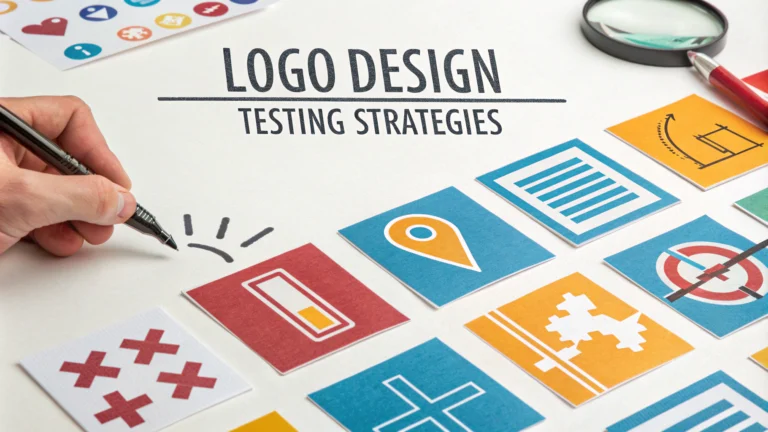Testing your logo design before finalizing it can save time, money, and potential rebranding headaches down the road.
Essential Logo Testing Methods
- Scalability Test: Resize your logo from favicon size to billboard dimensions to ensure clarity at all sizes
- Color Variations: Test in black and white, grayscale, and reversed colors
- Background Test: Place the logo on light, dark, and colored backgrounds
- Print Test: Print on different materials and sizes
- Digital Device Test: Check appearance across various screens and resolutions
A/B Testing with Target Audience
Gather feedback from your target demographic through online surveys or focus groups.
Key Questions for Testing:
- Does the logo communicate your brand values?
- Is it memorable after a brief viewing?
- Does it stand out among competitors?
- Is it appropriate for your industry?
Technical Testing Checklist
| Test Type | Method |
|---|---|
| File Format | Test in AI, EPS, PNG, JPG, SVG formats |
| Social Media | Check profile picture cropping on major platforms |
| Motion Test | Verify animation capabilities if needed |
Professional Testing Services
Consider using specialized logo testing services:
- UsabilityHub: www.usabilityhub.com
- Optimal Workshop: www.optimalworkshop.com
- UserTesting: www.usertesting.com
Common Testing Mistakes to Avoid
- Testing only on digital screens
- Neglecting to test across different applications
- Skipping competitor comparison tests
- Not testing with colorblind viewers
Final Testing Timeline
- Initial concept testing (2-3 days)
- Technical testing (1 week)
- Target audience feedback (1-2 weeks)
- Refinements based on feedback (1 week)
- Final approval testing (2-3 days)
Document all testing results and keep them for future reference or potential redesigns.
Testing Documentation Guidelines
Maintaining detailed records of your logo testing process helps track evolution and justify design decisions.
Key Elements to Document:
- Test dates and conditions
- Participant demographics
- Specific feedback received
- Technical challenges encountered
- Solutions implemented
Post-Launch Monitoring
Continue evaluating logo performance after implementation through:
- Social media engagement metrics
- Brand recognition surveys
- Customer feedback analysis
- Industry professional reviews
Iterative Improvements
Use collected data to make informed adjustments while maintaining brand consistency.
| Timeframe | Review Type |
|---|---|
| 3 months | Initial performance review |
| 6 months | Comprehensive analysis |
| 12 months | Full brand impact assessment |
Conclusion
Thorough logo testing is crucial for ensuring long-term brand success. By following systematic testing procedures, documenting results, and maintaining ongoing evaluation, organizations can develop and maintain effective visual identities that resonate with their target audience and stand the test of time.
Remember that logo testing is not a one-time event but an ongoing process that should evolve with your brand and market conditions. Regular assessment and willingness to make data-driven adjustments will help maintain your logo’s effectiveness and relevance.
FAQs
- What are the essential methods for testing a logo design before finalizing?
Test for scalability, check legibility at different sizes, conduct color variation tests, verify print and digital compatibility, gather stakeholder feedback, perform competitor analysis, test across different platforms, conduct A/B testing with target audience, review in grayscale, and test for cultural appropriateness. - How do I ensure my logo works well across different platforms and devices?
Test the logo on various screens (mobile, tablet, desktop), social media platforms, browser backgrounds, print materials, and merchandise. Create responsive versions and ensure it maintains clarity and impact across all applications. - What’s the importance of testing logo legibility at different sizes?
Size testing ensures the logo remains recognizable from large billboard displays down to small social media icons. Complex designs often lose detail at smaller sizes, so testing prevents visibility issues in real-world applications. - How can I test my logo’s cultural appropriateness?
Research cultural associations of symbols, colors, and shapes in target markets, conduct focus groups with diverse participants, consult cultural experts, and verify translations if text is included to avoid unintended meanings or offensive elements. - What tools should I use for logo design testing?
Use Adobe Creative Suite for technical tests, online mockup generators, color blindness simulators, survey tools for feedback collection, social media testing platforms, and print proofing services. - How do I conduct effective A/B testing for logo designs?
Present two versions to target audience segments, gather quantitative and qualitative feedback, measure recognition and recall rates, track emotional responses, and analyze which version better communicates brand values. - What’s the importance of testing a logo in grayscale?
Grayscale testing ensures the logo works in single-color applications, fax documents, and black-and-white printing. It also verifies that the design’s contrast and form remain effective without color. - How long should the logo testing phase last?
Typically 2-4 weeks for comprehensive testing, including stakeholder feedback, technical evaluations, audience testing, and necessary refinements. Complex projects may require longer testing periods. - What are the critical color tests for logo design?
Test CMYK and RGB color versions, verify Pantone color accuracy, check color-blindness accessibility, test against different backgrounds, and ensure brand color consistency across all applications. - How do I test logo recognition and memorability?
Conduct timed exposure tests, measure recall rates after various time intervals, perform side-by-side comparisons with competitor logos, and gather feedback on brand association strength through focus groups.








